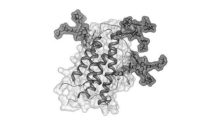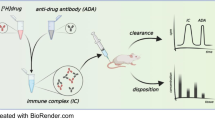Abstract
Pre-existing antibodies against a drug substance can significantly alter the pharmacokinetic profile of the drug in the circulation. Rapid clearance, mediated by complement or Fc receptors, occurs for crosslinked immune complexes, but not for complexes containing only one or two antibodies. With antibodies functioning as carrier proteins, monovalent antigens may enjoy a prolonged circulatory half-life, as observed in the case of digoxin, insulin, and various interleukins. While such an effect should be highly sensitive to fluctuations in antibody affinity and titer, it may present a means of extending the circulation of potent but rapidly cleared therapeutic agents. This mini-review attempts to delineate the causal relation between the factors influencing antibody binding and the circulatory life of a therapeutic agent, be it a small drug or a macromolecule.
Similar content being viewed by others
REFERENCES
M. Gibaldi. Biopharmaceutics and Clinical Pharmacokinetics, Lea and Febiger, Philadelphia, 1991.
W. Gregorio. Protein Interactions, Chapman and Hall, New York, 1992.
G. Winter and W. J. Harris. Humanized antibodies. Trends Pharmacol. Sci. 14:139–143 (1993).
Janeway and Travers. Immunobiology, 3rd Edition, Garland Press, 1997.
K. Rajewsky. In I. M. Roitt and P. J. Delves (eds.), Encyclopedia of Immunology, Academic Press, New York, 1992, pp. 40–41.
R. W. Lightfoot, R. E. Drusin, and C. L. Christian. Properties of soluble immune complexes. J. Immunol. 105:1493–1500 (1970).
M. Pascual and J. A. Schifferli. The binding of immune complexes by the erythrocyte complement receptor 1 (CR1). Immunopharmacology 24:101–106 (1992).
M. J. Walprot and K. A. Davies. Complement and immune complexes. Res. Immunol. 147:103–109 (1996).
K. A. Davies, K. Erlendsson, H. L. C. Beynon, A. M. Peters, K. Steinsson, H. Valdimarsson, and M. J. Walport. Splenic uptake of immune complexes in man is complement-dependent. J. Immunol. 151:3866–3873 (1993).
G. R. Strohmeier, B. A. Brunkhorst, K. F. Seetoo, T. Meshulam, J. Bernardo, and E. R. Simons. Role of the FCγR subclasses FcγRII and FcγRIII in the activation of human neutrophils by low and high valency immune complexes. J. Leukocyte Biol. 58:415–422 (1995).
M. Head, N. Meryhew, and O. Runquist. Mechanism and computer simulation of immune complex formation, opsonization, and clearance. J. Lab. Clin. Med. 128:61–74 (1996).
A. Rascu, R. Repp, N. A. C. Westerdaal, J. R. Kalden, and J. G. J. van de Winkel. Clinical relevance of Fcγ receptor polymorphisms. Annals N.Y. Acad. Sci. 815:282–295 (1997).
M. Mannik, A. O. Haakenstad, W. P. Arend. The fate and detection of circulating immune complexes. Prog. in Immunol. II 5:91–101 (1974).
T. Skogh, O. Stendahl, T. Sundqvist, and L. Edebo. Physiochemical properties and blood clearance of human serum albumin conjugated to different extents with dinitrophenyl groups. Int. Arch. Allergy Appl. Immun. 70:238–241 (1983).
D. H. Schmidt, B. M. Kaufman, and V. P. Butler. Persistence of hapten-antibody complexes in the circulation after a single intravenous injection of hapten. J. Exp. Med. 139:278–294 (1974).
V. P. Butler, D. H. Schmidt, T. W. Smith, E. Haber, B. D. Raynor, and P. Demartini. Effects of sheep digoxin-specific antibodies and their Fab fragments on digoxin pharmacokinetics in dogs. J. Clin. Invest. 59:345–359 (1984).
N. M. Griffiths, D. S. Hewick, and I. H. Stevenson. The effect of immunization with digoxin-specific antibodies on digoxin disposition in the mouse. Biochem. Pharmacol. 33:3041–3046 (1984).
M. P. Timsina and D. S. Hewick. The plasma disposition and renal elimination of digoxin-specific Fab fragments and digoxin in the rabbit. J. Pharm. Pharmacol. 44:796–800 (1992).
N. M. Griffiths, D. S. Hewick, and I. H. Stevenson. The serum pharmacokinetics of digoxin as an immunogen and hapten in the rabbit. Int. J. Immunopharmac. 7:697–703 (1985).
M. R. Ujhelyi, S. Tobert, D. M. Cummings, R. D. Colucci, P. J. Green, J. Saistad, P. H. Vlasses, and B. J. Zarowitz. Influence of digoxin immune Fab therapy and renal dysfunction on the disposition of total and free digoxin. Ann. Intern. Med. 119:273–277 (1993).
J. L. Valentine and S. M. Owens. Antiphencyclidine monoclonal antibody therapy significantly changes phencyclidine concentrations in brain and other tissues in rats. J. Pharmaco. Exp. Ther. 278:717–724 (1996).
J. M. Scherrmann, M. Urtizberea, P. Pierson, and N. Terrien. The effect of colchicine-specific active immunization on colchicine toxicity and disposition in the rabbit. Toxicology 56:213–222 (1989).
A. Peters, O. Klose, R. Hefty, F. Keck, and W. Kemer. The influence of insulin antibodies on the pharmacokinetics of NPH insulin in patients with type 1 diabetes treated with human insulin. Diabetic Med. 12:925–930 (1995).
G. B. Bolli, G. D. Dimitradis, G. B. Pehling, B. A. Baker, M. W. Haymond, P. E. Cryer, and J. E. Gerich. Abnormal glucose counterregulation after subcutaneous insulin in insulin-dependent diabetes mellitus. NEJM 310:1706–1711 (1984).
T. W. Van Haeften, B. B. Bolli, G. D. Dimitriadis, I. S. Gotesman, D. L. Horwitz, and J. E. Gerich. Effect of insulin antibodies and their kinetic characteristics on plasma free insulin dynamics in patients with diabetes mellitus. Metabolism 35:649–656 (1986).
R. S. Gray, P. Cowan, U. Mario, R. A. Elton, B. F. Clarke, and L. J. P. Duncan. Influence of insulin antibodies on pharmacokinetics and bioavailability of recombinant human and highly purified beef insulins in insulin dependent diabetics. Brit. Med. J. 290:1687–1691 (1985).
K. Bendtzen, M. B. Hansen, C. Ross, and M. Svenson. High avidity autoantibodies to cytokines. Immunol. Today 19:209–211 (1998).
L. P. Courtney, J. L. Phelps, and L. M. Karavodin. An anti-IL-2 antibody increases serum half-life and improves anti-tumor efficacy of human recombinant interleukin-2. Immunopharmacol. 28:223–232 (1994).
J. Sato, N. Hamaguchi, K. Doken, S. Iwasa, Y. Ogawa, and H. Toguchi. Pharmacokinetic alteration in rats of recombinant interleukin-2 (rIL-2) by immunocomplexing with a monoclonal antibody against rIL-2. Biol. Pharm. Bull. 17:535–538 (1994).
A. T. Jones and H. J. Ziltener. Enhancement of the biologic effects of interleukin-3 in vivo by anti-interleukin-3 antibodies. Blood 82:1133–1141 (1993).
F. D. Finkelman, K. B. Madden, S. C. Morris, J. M. Holmes, N. Boiani, I. M. Katona, and C. R. Maleszewski. Anti-cytokine antibodies as carrier proteins. J. Immunol. 151:1235–1244 (1993).
E. Martens, C. Dillen, W. Put, H. Heremans, J. V. Damme, and A. Billiau. Increased circulating interleukin-6 (IL-6) activity in endotoxin-challenged mice pretreated with anti-IL-6 antibody is due to IL-6 accumulated in antigen-antibody complexes. Eur. J. Immunol. 23:2026–2029 (1993).
H. Suzuki, H. Takemura, K. Yoshizaki, Y. Koishihara, Y. Ohsugi, A. Okano, Y. Akiyama, T. Tojo, T. Kishimoto, and H. Kashiwagi. IL-6-anti-IL-6 autoantibody complexes with IL-6 activity in sera from some patients with systemic sclerosis. J. Immunol. 152:935–942 (1994).
W. C. Greene, L. S. Park, and T. Kishimoto. In I. M. Roitt and P. J. Delves (eds.) Encyclopedia of Immunology, Academic Press, New York, pp. 906–920, 1992.
F. A. Montero-Julian, B. Klein, E. Gautherot, and H. Brailly. Pharmacokinetic study of anti-interleukin-6 (IL-6) therapy with monoclonal antibodies: enhancement of IL-6 clearance by cocktails of anti-IL-6 antibodies. Blood 85:917–924 (1995).
K. M. Shokat and P. G. Schultz. Redirecting the immune response: ligand-mediated immunogenicity. J. Am. Chem. Soc. 113:1861–1862 (1991).
A. R. Lussow, L. Gao, M. Block, R. Buelow, P. Pouletty. Targeting of antihapten antibodies to activated T cells via an IL-2-hapten conjugate prolongs cardiac graft survival. Transplantation 62:1703–1708 (1996).
M. J. Cho and R. L. Juliano. Macromolecular versus small-molecule therapeutics: drug discovery, development and clinical considerations. Trends in Biotech. 14:153–158 (1996).
M. F. Bachmann, U. Kalinke, A. Althage, G. Freer, C. Burkhart, H. P. Roost, M. Aguet, H. Hengartner, and R. M. Zinkernagel. The role of antibody concentration and avidity in antiviral binding. Science 276:2024–2027 (1997).
Author information
Authors and Affiliations
Rights and permissions
About this article
Cite this article
Rehlaender, B.N., Cho, M.J. Antibodies as Carrier Proteins. Pharm Res 15, 1652–1656 (1998). https://doi.org/10.1023/A:1011936007457
Issue Date:
DOI: https://doi.org/10.1023/A:1011936007457




